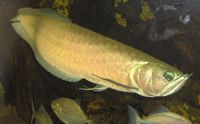Silver Arowana (Osteoglossum bicirrhosum)
From The Aquarium Wiki
Silver Arowana
Osteoglossum bicirrhosum
946 Litres (250 US G.)
80-90 cm (31.5-35.4")
Freshwater
6.0 - 7.2
24 -28 °C (75.2-82.4°F)
3-10 °d
1:1 M:F
8-25 years
Family
Osteoglossidae
Contents
Additional names
- Silver Arowana, Dragon Fish, Arawana
Additional scientific names
- Isochnosoma bicirrhosum, Osteoglossum vandelli
Origin
- South America: Amazon River basin, Rupununi and Oyapock Rivers.
Sexing
- Very difficult to sex visually. Mature females are generally more rounded in the body and have a slightly shorter anal fin.
Breeding
- Arowanas form pairs in the juvenile stages. Typically a commercial breeder will have a large group in a pond or concrete tank. Groups of up to 20 will be in this area. As courting begins, pairs will begin to form and the male will attempt to move in close proximity to the female. If the female will accept the male, the pair will swim in tight semi circles. The female will drop her eggs and the male will fertilize them and store the fertilized eggs in his buccal cavity. The males will carry the eggs and incubate them. Fry will live out of the fathers mouth for the beginning, very similar to what is found in mouthbrooding cichlids. Fry are generally considered safe to keep once the yolk sac is fully absorbed. Young Arowanas should not be bought when their yolk sac is still attached.
Tank compatibility
- Arowana being a fish that inhabits the surface area, most bottom dwelling fish are considered to be compatible. This does not go without exception. Arowana do not normally feed on other fish, but if the caregiver does not establish a proper diet early on, Arowana have a tendency to stick to one diet. Changing an Arowana's diet usually involves starving off the food source they prefer, and continual offering of the foods you wish it to eat.
- Fish that reach bigger sizes are usually a good choice to tank mate with an Arowana. Schooling fish offer safety of the group. Mid sized Tetra's, Silver Dollars, Tin Foil Barbs, bottom dwellers, Freshwater Rays and semi-aggressive large South American Cichlids will work out with South American Arowana. You'd want to avoid the African Cichlids for the most part, as the higher PH and hardness is likely to cause stress or death of a South American Arowana.
Diet
- Feeder fish, or other type of smaller fish are not a good choice for two reasons. One being that feeder fish found commercially typically have low level of care given to them, harbour many unwanted pathogens, and are very low in nutritional value. Secondly, teaching an Arowana to eat other fish will promote the onset of Drop Eye.
- Arowana are primarily a surface dwelling fish. Their diet will consist of food that is visible on the surface. At younger stages of life, Arowana would feed on water bugs, insect larvae or anything else it could fit in it's mouth. As the Arowana ages and the mouth grows, it could well move up to rodents and birds that might inhabit the surface area. This fish's natural habitat is the Amazon River Basin. In a tank, the caregiver must consider the diet. Frozen bloodworm cubes or brine shrimp cubes would be a good food source for a young Arowana as well as baby crickets. As your Arowana ages, move up to larger crickets, shrimp, mussels, cockles and frogs. The key to feeding the Arowana is keeping foods on the surface.
Feeding regime
- Feed once a day. These fish are prone to Drop Eye in captivity, so feed them carefully.
Environment specifics
- A laterally long tank is a must for this fish, width is more important than depth, the Silver Arowana must have room to turn around as it's not very flexible! A secure lid is a must as the Silver Arowana is purely top-dwelling and can jump.
- If this fish is kept in a tank too small for it and it's not able to turn around it may suffer from "gill curl", where the gill plates curl outwards and will cause the fish to have to swim backwards in order to breathe properly and susceptible to gill infections.
Behaviour
- Most are entirely carnivorous, often being specialized surface feeders. They are excellent jumpers and it has been reported that Osteoglossum species have been seen leaping more than 6 feet (almost 2 metres) from the water surface to pick off insects from overhanging branches in South America, hence the nickname "Water monkeys". Arowanas have been rumoured to capture prey as large as low flying bats and small birds. All species are large, and the Arapaima is a contender for the world's largest freshwater fish.
Identification
- An elongate fish with a large upturned mouth and two "feelers" on its lip. The Silver Arowana in silver in colour through the body and fins with large scales. The caudal fin is small with both anal and dorsal fins extending along half of the fish's body.
- A white arowana, or "Snow Arowana"/"Platinum Arowana" has been seen, this is a rare leusistic morph.
- It must not be confused with the Black Arowana. The Black Arowana looks almost identical to the Silver Arowana, as the fish ages the eye bands and dark colouration are lost, leaving adult fish a darkish silvery colour. Most Black Arowanas retain a silver-blue hue in their fins.
Species Notes
- The Silver Arowana in the wild is under threat from over collecting. Collectors will kill adult fish to collect their young, as Arowana are defensive mouth brooders. If you are purchasing a Silver Arowana, please make sure you try and get captive bred.
Pictures
Videos
| In a large community tank: | Platinum "Snow" Arowana at Aquarama 2007: |
External links
- Fishbase (Mirrors:
 )
)
- Wikipedia
- Arowana Club
- Fish Forums.net
- Practical Fishkeeping - Silver Arowanas Under Threat
- Connect Fish Friends - Silver Arowanas Under Threat


